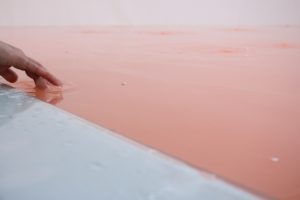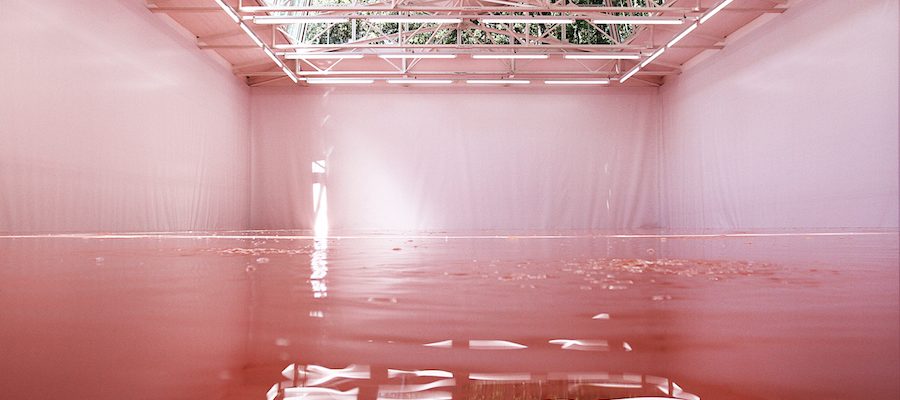At The Venice Art Biennale 2015 All the World’s futures the artist Pamela Rosenkraz transformed the whole swiss pavillon into a multisensory environment dominated by a pool filled with a skin-tone colored liquid. The exhibition entitled Our product was composed of immaterial elements such as light, color, scent, sound and organic components such as hormones and bacteria.

By covering the floor with a mixture of various synthetic and organic substances she created a liquid imitating the human skin which also juxtaposes artificial and natural dimensions of a body. In this way she questions the understanding of a human based on their physiology and cultural history. Furthermore in order to evoke a synthetic reality she invaded all of the viewers’ senses by the use of smells (of fresh baby skin) and synthetic sounds of water, generated by an algorithm in real time.
In this way the installation appropriates aesthetics from our everyday life but in a setting where it’s hard to figure out, if ones physiological response is triggered by imagination alone or if the experienced effects are a hallucinatory product of ones body and constructed history
The immersive installation questions our conception of the real by confronting the historically, religiously, and commercially transmitted image of what it means to be human with its biological genesis. Like the rendering discussion about AI-intelligence and the case of the Turing test it asks: what does it take to be accepted as real/as human? Is it enough to mime or look like it, if it can fool the viewer/test person to believe in it?
Following this motive, the exhibition can be seen as a subtle illustration of the Object Oriented Ontologi (OOO), namely the claim that all things do exist beyond the purview of human conception and that existence is almost entirely inaccessible to our understanding. As Harman one of the founders of OOO writes, “The world is not the world as manifest to humans; to think a reality beyond our thinking is not nonsense, but obligatory”
This viewpoint is in accordance with Nagel’s point about the impossibility in experiencing batness in spite of the knowledge of its intrinsic qualities. We will never understand and access the subjectivity of the other but “This does not prevent us each from believing that the other’s experience has such a subjective character.” (Nagel:1974)

I will let the curator of the exhibition speak for the rest:
“out of a mix ture of water, methane, ammonia, hydrogen, and the energy provided by the sun, amino acids, membrane blebs, and the first forms of life on earth emerged. even if the demise of both the sun and the earth lie in the distant future, thinking a universe beyond humanity and conceptualizing matter as inherently intelligible are among the urgent tasks of our present. (..)
(..) if matter is indeed in itself intelligible, the anthropocentric construction of humanity turns out to be obsolete. the boundaries between human beings, nature, animals, and matter are becoming more porous than ever. at a time when synthetic particles can be found in water, sediments, and suspended solids, and when we know that they already permeate human bodies, animals, and plants; at a time when humans gradually transform into cyborgs, the foundational distinction between ‘organic’ and ‘synthetic’ evaporates. furthermore, the concept of ‘self’ is undergoing a profound transformation in the neurosciences. this is a self based on permanent change: a liquid self. inside and outside, active and passive — these are no longer clearly definable oppositions. as a consequence, the construction of the human needs to take stock of the new prevalence of fluidity and change”
(..) if matter is indeed in itself intelligible, the anthropocentric construction of humanity turns out to be obsolete. the boundaries between human beings, nature, animals, and matter are becoming more porous than ever. at a time when synthetic particles can be found in water, sediments, and suspended solids, and when we know that they already permeate human bodies, animals, and plants; at a time when humans gradually transform into cyborgs, the foundational distinction between ‘organic’ and ‘synthetic’ evaporates. furthermore, the concept of ‘self’ is undergoing a profound transformation in the neurosciences. this is a self based on permanent change: a liquid self. inside and outside, active and passive — these are no longer clearly definable oppositions. as a consequence, the construction of the human needs to take stock of the new prevalence of fluidity and change” – susanne pfeffer, curator of the pavilion of switzerland at the 2015 venice biennale
References: Nagel, Thomas: “What is it like to be a Bat?”, The Philosophical Review; Vol. 83, No. 4 (Oct., 1974), pp. 435-450
Link to the exhibition:
http://www.contemporaryartdaily.com/2015/05/venice-pamela-rosenkranz-at-the-swiss-pavilion/

Leave a Reply
Be the First to Comment!